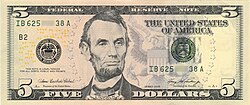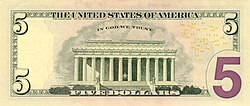| Country | United States |
|---|---|
| Value | $5 |
| Width | 6 9/64 inches ≈ 156 mm |
| Height | 2 39/64 inches ≈ 66.3 mm |
| Weight | 0.035 oz. ≈ 1 [1] g |
| Security features | Security fibers, watermark, security thread, micro printing, raised printing, EURion constellation |
| Material used | 75% cotton 25% linen |
| Years of printing | 1861–present |
| Obverse | |
 | |
| Design | Abraham Lincoln |
| Design date | 2006 |
| Reverse | |
 | |
| Design | Lincoln Memorial |
| Design date | 2006 |

The United States five-dollar bill (US$5) is a denomination of United States currency. The current $5 bill features U.S. president Abraham Lincoln and the coat of arms of United States on the front and the Lincoln Memorial on the back. All $5 bills issued today are Federal Reserve Notes. As of December 2018 [update] , the average life of a $5 bill in circulation is 4.7 years before it is replaced due to wear. [3] Approximately 6% of all paper currency produced by the U.S. Treasury's Bureau of Engraving and Printing in 2009 were $5 bills. [4]
Contents
- Current design
- Security features
- Design features
- Proposed redesign
- Large size note history
- Small size note history
- Series dates
- See also
- References
- External links
The note was formerly nicknamed a "fin", a term from Yiddish פֿינף (finf), פֿינעף (finef), meaning "five;" this term derived from underworld slang and originally referred to the British five-pound note. It was first recorded being used to refer to the American bill in 1925. [5] [6] It is also occasionally referred to as a “fiver”. [7]







